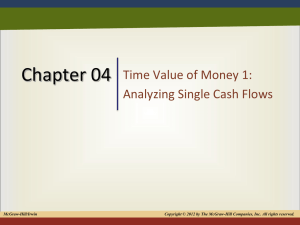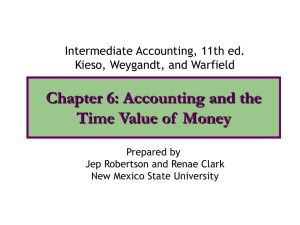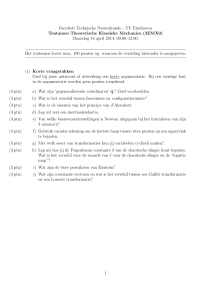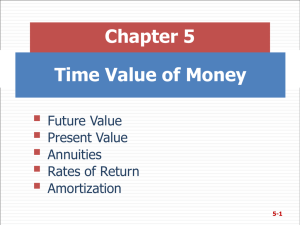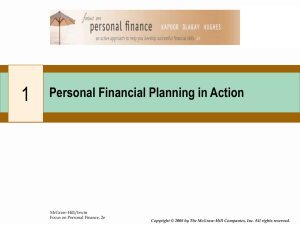Chapter 1 The Time Value of Money
advertisement
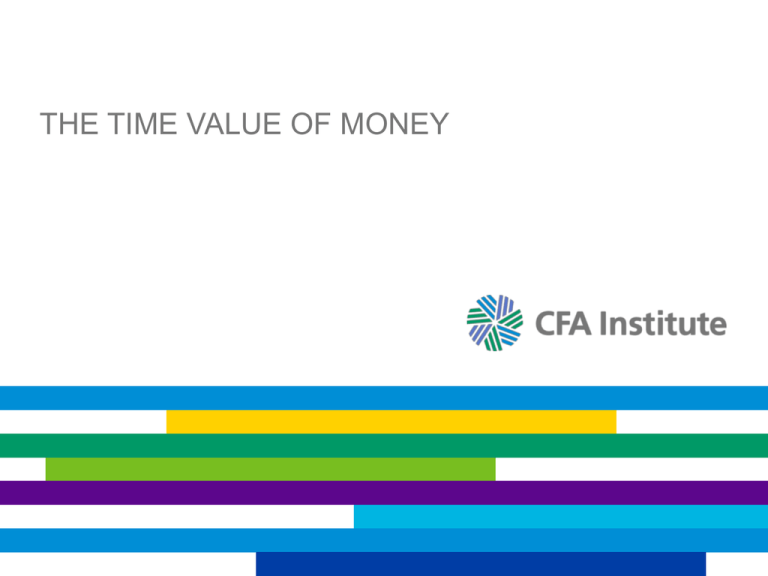
THE TIME VALUE OF MONEY DECOMPOSING INTEREST RATES We often view interest rates as compensation for bearing risk. • Interest rates can then be viewed as compensation for - Delaying consumption “risklessly” (the risk-free real rate, Rf) - Bearing inflation risk over the life of the instrument (inflation risk premium, or IRP) - The possibility that the borrower will not make the promised payments at the promised time (default risk premium, or DRP) - The possibility that the investor will need to convert the investment to cash quickly and will not receive a fair value (liquidity risk premium, or LRP) - The increased sensitivity of longer-maturity instruments to changes in prevailing market rates (maturity risk premium, or MRP) r = 𝑅𝑓 + IRP + DRP + LRP + MRP Nominal Risk-Free Rate (approximately) 2 THE TIME VALUE OF MONEY Compounding is the process of moving cash flows forward in time. Discounting is the process of moving cash flows back in time. • Time value of money problems help us assess equivalency of differing cash flow streams across time, including - The value today (present value, or PV) of a single amount we will receive in the future (future value, or FV) - The value today (PV) of a stream of equally sized cash flows to be received at uniform increments of time in the future (payments or annuity, PMT or A) - The value today (PV) of a stream of unequally sized and/or timed cash flows in the future (CF) - The future values of the above - The annuitized values of the above Time Discounting Compounding 3 DIFFERENT INTEREST RATES The frequency with which interest is calculated is known as compounding. • Simple interest is the amount of principal times the stated rate of interest for a single period with no compounding. - If the period of time for which we are examining simple interest is less than a year, the interest rate for a single period is known as a periodic rate. • If the instrument pays interest more than once a year, the interest rate will generally be known as a stated annual interest rate or a quoted interest rate. - The expression of the rate will then typically be followed by an indication of how often interest is calculated. - For example: 12% compounded monthly • By convention, we can then calculate the monthly rate of simple interest (also known as the monthly periodic rate) as 0.12/12 = 0.01. 4 COMPARING INTEREST RATES • You may encounter investments with different stated rates of interest and different compounding frequencies. • To compare such rates, you need a common reference time period and a method for combining the rates and compounding periods such that a comparison is accurate. • The equivalent annual rate (EAR) is just such a rate. Once calculated, EAR represents the interest rate across one year that would have been earned on an equivalent stated rate of interest with no intrayear compounding. EAR = (1 + Periodic interest rate)m – 1 where m is the number of times compounding will occur in one year 5 COMPARING INTEREST RATES Focus On: Calculations Stated Annual Rate Periodic Rate No. Compounding Periods 10% monthly compounding 0.8333% 12 10.4713% 10% quarterly compounding 2.5% 4 10.3813% 10% semiannual compounding 5% 2 10.25% 10% annual compounding 10% 1 10% EAR EAR = (1 + Periodic interest rate)m – 1 6 FUTURE VALUE (FV) Given a present value (PV), we can compound to return a future value (FV). • If we have $1,000 today that we put in an exchange-traded fund that will generate 12% per year for the next two years, how much will we have in the account in two years? FV2 = $1,254.40 PV0(1 + r)N = FVN t=0 t=1 r = 12% t=2 r = 12% t=0 t=1 t=2 PV0 = $1,000 7 PRESENT VALUE (PV) Given a future value (FV), we can discount it to return a present value (PV). • If we expect to receive a check for $25,000 in three years and our opportunity cost of funds is 9%, the present value of the future payment is FVN PV0 = 1+𝑟 𝑁 FV3 = $25,000 r = 9% t=0 t=0 t=1 t=2 t=1 t=3 t=2 t=3 r = 9% PV0 = $19,604.59 $19,304.59 = $25,000 1 + 0.09 3 8 CHANGING THE COMPOUNDING FREQUENCY Periodic Rates and the Time Value of Money • Whenever we make TVM calculations, the period of time associated with the frequency of cash flows must match the compounding frequency for our discounting or compounding rate. To address any differences, - Make any necessary adjustment to convert the stated annual rate to the appropriate periodic rate Stated rate/Compounding frequency = Periodic rate - Make any necessary adjustment to the time index to account for the compounding frequency Number of years x Compounding frequency • What is the present value of a single lump sum of $1,500 to be received in two years if the stated rate of interest is 6% semiannually compounded? - r 0.06/2 = 0.03 periodic rate - N 2 x 2 = 4 periods PV0 = FV𝑁 1+𝑟 𝑁 = $1,500 0.06 2 2 1+ 2 = $1,332.7306 9 FV OF AN ANNUITY (A) Calculate the future value of a series of regular payments at regular intervals. • If you invest $10,000 each year for the next two years at 11% starting in one year, how much will you have at the end of the two years? 1+𝑟 𝑁−1 FV𝑁 = 𝐴 𝑟 A2 = $10,000 r = 11% t=0 FV3 = $21,100 A3 = $10,000 r = 11% t=1 t=2 t=0 t=1 t=2 10 PV OF AN ANNUITY (A) Calculate the present value of a series of regular payments received at regular intervals. • If you expect to receive $10,000 each year for two years starting in one year, and your opportunity cost is 11%, how much is it worth today? 1− PV0 = 𝐴 A2 = $10,000 r = 11% 1 1+𝑟 𝑟 A3 = $10,000 r = 11% t=0 t=1 r = 11% t=0 t=1 𝑁 t=2 r = 11% t=2 PV0 = $17,125.23 11 ANNUITY DUE VALUES An annuity due is just like an annuity except that the first payment is received (paid) at the beginning of a period rather than the end. • You can find the PV (FV) of an annuity due in several ways: - Take the PV (FV) of each individual part to a common point in time and use value additivity to combine them. - Treat it as an annuity, combine the cash flows at the annuity origin in time, and then move the resulting cash flow to the desired point in time - Treat it as a single lump sum and an ordinary annuity of one period shorter, and then calculate the PV (FV) of each component and add them together, again using value additivity. + - Depicted: Three-period annuity due as a twoperiod annuity and a single lump sum. 12 ANNUITY DUE VALUES Focus On: Calculations A0 = $1,000 • You currently own a rental house that yields annual rent of $1,000. There is a rent payment due today and one each at the end of the next two years. If you deposit all three into your bank account, which earns 2%, how much money will you have at the end of Year 2? A1 = $1,000 t = 0 r = 2% t = 1 r = 2% A2 = $1,000 t=2 A0 = $1,000 𝑁−1 1 + 𝑟 FV2 = PV0 1 + 𝑟 𝑁 + 𝐴 𝑟 FV2 = $1000 1 + 0.02 2 + $1000 1 + 0.02 − 1 0.02 2 t=0 r = 2% t = 1 r = 2% + A1 = $1,000 t=2 A2 = $1,000 FV2 = $3060.40 t=0 r = 2% t = 1 r = 2% t=2 13 PRESENT VALUE OF A PERPETUITY Cash flows that never end are known as perpetuities. • These can occur with many types of investments, including stocks and bonds. - A type of perpetual bond is a “consol.” • Suppose you plan to invest in a utility stock that will pay a $2 dividend for the life of the company. You don’t expect the dividend to ever grow, and similar stocks have an 8% required rate of return. How much should the stock be worth today? ∞ PV0 = 𝐴 𝑖=1 A2 = $2 1 𝐴 ≅ (1 + 𝑟)𝑖 𝑟 r = 8% t=0 A3 = $2 r = 8% t=1 t=2 14 PRESENT VALUE OF A GROWING PERPETUITY If we assume growth stays constant and it is less than the discount rate, then we can calculate the present value of a growing perpetuity. • Suppose you plan to invest in a different utility stock that will pay a $2 dividend for the life of the company. You expect the dividend to grow (g) by 2% per year, and similar stocks have an 8% required rate of return. How much should the A3 = $2(1.02)(1.02) stock be worth today? A3 = $2(1.02) A2 = $2 t=0 r = 8% g = 2% r = 8% g = 2% t=1 ∞ PV0 = 𝐴 𝑖=1 r = 8% g = 2% r = 8% g = 2% t=2 t=3 1+𝑔 𝑖 𝐴1 2 1 + 0.02 ≅ = = $34 1 + 𝑟 𝑖 𝑟 − 𝑔 0.08 − 0.02 15 SOLVING COMPLEX TVM PROBLEMS We can use value additivity and cash flow diagrams to solve complex TVM problems more easily. • Consider a stock that currently pays no dividend. In one year, it is expected to pay a $1 dividend. The year after, it will pay $2 for three years. After that, the dividends will grow at a constant rate of 10% per year forever. If you require a 12% rate of return on the stock, what is its value to you today? A5 = $2(1.1) = $2.20 A2 = $2 A3 = $2 A4 = $2 A1 = $1 r = 8% r = 8% g = 2% g = 2% t=0 t=1 t=2 t=3 Nonconstant growth t=4 t=5 r = 8% g = 2% t=6 Constant growth PV = ? 16 SOLVING COMPLEX TVM PROBLEMS We can use value additivity and cash flow diagrams to solve complex TVM problems more easily. • This can be viewed as 1) A single lump sum at t = 1 + a 3-period annuity from t = 2 to 4 + growing perpetuity or 2) Four single lump sums at times t = 1, 2, 3, 4 + a growing perpetuity. A5 = $2(1.1) = $2.20 A2 = $2 A3 = $2 A4 = $2 A1 = $1 t=0 t=1 t=2 t=3 Nonconstant growth t=4 t=5 t=6 Constant growth PV = ? 17 SOLVING COMPLEX TVM PROBLEMS Focus On: Calculations • Solution for approach 1: PV0 = PV0 = $1 1 + 0.08 1 + $2 1 1 + 0.08 0.08 1 + 0.08 1 1− 3 $2(1.02) + 0.08 − 0.024 1 + 0.08 $1 $5.1542 $34 + + = $30.6893 (1 + 0.08)1 (1 + 0.08)1 (1 + 0.08)4 • Solution for approach 2: $2(1.02) $1 $2 $2 $2 0.08 − 0.02 PV0 = + + + + (1 + 0.08)1 (1 + 0.08)2 (1 + 0.08)3 (1 + 0.08)4 (1 + 0.08)4 PV0 = $30.6893 18 MOVING AWAY FROM THE ORIGIN Focus On: Calculations • We can modify our existing time value of money calculations to determine values at points in time other than the origin (t = 0). • When we do this, “N” becomes the number of intervening periods between our time of interest and each cash flow. • Say you want to withdraw $75,000 a year for two years, starting at the end of four years. How much money must you have in your account at the end of three years to do so if the account earns 5% interest? - You have a two-period annuity, so N = 2 with the payments starting at t = 4. PV3 = 𝐴4 1− 1 1−𝑟 𝑟 𝑁 19 MOVING AWAY FROM THE ORIGIN Focus On: Calculations • You have an annuity that begins at t = 4 for which you want to know the value at t = 3. PV3 = FV3 = ? t=4 t=0 t=1 t=2 t=3 A4 = –$75k 1− PV3 = $75,000 t=5 1 1 + 0.05 0.05 2 A5 = –$75k = $139,455.7823 20 SOLVING FOR UNKNOWN VALUES IN TVM PROBLEMS Focus On: Calculations • You have decided to start your own firm. Being prudent, you want to have enough money saved to use for living expenses for two years before you quit. You can currently put away $45,000 a year. You know that you will have living expenses of $75,000 a year for each of the two years (paid at the end of the year, simplifying assumption). You would like to quit in three years. If you put $45,000 into an account bearing 5% interest each of the next two years, how much must you put into the account at the end of Year 3 so that you can quit? A1 = $45K A2 = $45K FV3 = ? t=4 t=0 t=1 t=2 t=5 t=3 A4 = –$75K A5 = –$75K 21 SOLVING FOR UNKNOWN VALUES IN TVM PROBLEMS Focus On: Calculations • Solution 1: Realize that the total amount of inflows = total outflows at any point in time once you have accounted for timing (interest) differences. PV0 = $45,000 $45,000 FV3 + + 1 + 0.05 1 1 + 0.05 2 1 + 0.05 + 3 – $75,000 – $75,000 + =0 1 + 0.05 4 1 + 0.05 5 • Solution 2: Group the positive and negative cash flows at t = 3 and the difference will be the deposit that is needed. −$75,000 −$75,000 2 1 FV3 = $45,000 1.05 + $45,000 1.05 + + 1 + 0.05 1 1 + 0.05 2 Compound out Compound out Discount back Discount back 22 SOLVING FOR UNKNOWN VALUES IN TVM Focus On: Verifying the Solution Year 1 Beg Balance — Cash Flow $45,000.00 Interest — Ending Balance $45,000.00 2 $45,000.00 $45,000.00 $2,250.00 $92,500.00 3 $92,500.00 $42,593.2823 $4,612.50 $139,455.7823 4 $139,705.7823 –$75,000.00 $6,972.7891 $71,428.5714 5 $71,428.5714 –$75,000.00 $3,571.4286 $0.00 23 PRESENT VALUE OF A SERIES OF UNEQUAL CASH FLOWS Using value additivity, we can break down complex cash flows into component parts. • You can invest today in a financial instrument that will pay you $40 every year starting at the end of this year for the next five years and $1,000 at the end of the five years. If you require a 12% return, how much should you be willing to pay for this instrument? - This is an annuity of $40 for five years and a future lump sum of $1,000 at the end of the five years. FV5 = $1,000 A1 = $40 r = 12% t=0 A2 = $40 r = 12% t=1 r = 12% t=2 1− PV0 = $40 A3 = $40 1 1 + 0.12 0.12 r = 12% t=3 5 A4 = $40 + A5 = $40 r=12% t=4 $1,000 1 + 0.12 5 t=5 = $711.62 24 CASH FLOW DIAGRAMS Organizing TVM problems with cash flow diagrams helps us visualize and solve complex problems. These are also known as time lines. • Cash flow diagrams depict - The timing of each cash flow, its amount, and its sign - The rate at which cash flows will be compounded/be discounted/grow. - The value for which we are attempting to solve. FV5 = CF1 = t=0 Ir = CF2 = r= t=1 CF3 = r= t=2 CF4 = r= t=3 CF5 = r= t=4 t=5 PV0 = 25 1+𝑟 𝑁−1 FV5 = 𝐴 𝑟 CASH FLOW DIAGRAMS Focus On: The Savings Problem • You are saving for a new car and have calculated that you will be able to make five payments before you need to buy the car. Your stock market account is expected to earn 8% each year, and you will need $45,000 to buy the car you want. How much must you save each year to buy the car at the end of five years? FV5 = $45,000 CF1 = ? t=0 r = 8% CF2 = ? r = 8% t=1 CF3 = ? r = 8% t=2 CF4 = ? r = 8% t=3 CF5 = ? r = 8% t=4 t=5 26 1− CASH FLOW DIAGRAMS PV0 = 𝐴 1 1+𝑟 𝑟 𝑁 Focus On: The Mortgage Problem • Along with your new car in five years, you have decided to buy a new house now. Current mortgage rates are 4% per month, and you have decided to finance the house for 30 years. The house you want is $860,000, and you are able to finance 80% of that. How much will your payment be? CF1 = ? t=0 r = 1/3% CF2 = ? r = 1/3% t=1 CF3 = ? r = 1/3% t=2 CF4 = ? r = 1/3% t=3 CF360 = ? r = 1/3% t=4 t = 360 PV0 = $860,000(.8) = $688,000 27 BASIC PRINCIPLES OF TVM • You cannot add or subtract cash flows that occur at different times without first compounding or discounting them to the same point in time. - Once at the same point in time, we can add or subtract the resulting equivalency cash flows. - This is known as the cash flow additivity principle: If two or more cash flows occur at the same point in time, we can add or subtract them together. - One implication of this is that we can add cash flow patterns together once we account for the differences in timing. • The period of time associated with the cash flows must match the period of time associated with the discounting or compounding rate (use periodic rates for compounding and discounting). • Pay close attention to the “when” in time for which you need an answer. 28 SUMMARY • The quantitative processes underlying the time value of money and its associated calculations are central to the investment process. - Using the time value of money concepts, we can - Determine the value of a series of future cash flows today (present value) - Determine the value of a series of cash flows in the future (future value) - Determine the value of a regular series of cash flows, known as an annuity, that is equivalent to a specific value today or in the future (annuitizing) • Valuation, a key function in the investment process, is often performed using the time value of money calculation known as present value. 29
